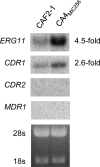Voriconazole-induced inhibition of the fungicidal activity of amphotericin B in Candida strains with reduced susceptibility to voriconazole: an effect not predicted by the MIC value alone
- PMID: 21282443
- PMCID: PMC3067173
- DOI: 10.1128/AAC.00791-10
Voriconazole-induced inhibition of the fungicidal activity of amphotericin B in Candida strains with reduced susceptibility to voriconazole: an effect not predicted by the MIC value alone
Abstract
An antagonistic effect of voriconazole on the fungicidal activity of sequential doses of amphotericin B has previously been demonstrated in Candida albicans strains susceptible to voriconazole. Because treatment failure and the need to switch to other antifungals are expected to occur more often in infections that are caused by resistant strains, it was of interest to study whether the antagonistic effect was still seen in Candida strains with reduced susceptibility to voriconazole. With the hypothesis that antagonism will not occur in voriconazole-resistant strains, C. albicans strains with characterized mechanisms of resistance against voriconazole, as well as Candida glabrata and Candida krusei strains with differences in their degrees of susceptibility to voriconazole were exposed to voriconazole or amphotericin B alone, to both drugs simultaneously, or to voriconazole followed by amphotericin B in an in vitro kinetic model. Amphotericin B administered alone or simultaneously with voriconazole resulted in fungicidal activity. When amphotericin B was administered after voriconazole, its activity was reduced (median reduction, 61%; range, 9 to 94%). Levels of voriconazole-dependent inhibition of amphotericin B activity differed significantly among the strains but were not correlated with the MIC values (correlation coefficient, -0.19; P = 0.65). Inhibition was found in C. albicans strains with increases in CDR1 and CDR2 expression but not in the strain with an increase in MDR1 expression. In summary, decreased susceptibility to voriconazole does not abolish voriconazole-dependent inhibition of the fungicidal activity of amphotericin B in voriconazole-resistant Candida strains. The degree of interaction could not be predicted by the MIC value alone.
Figures




Similar articles
-
Characterization of the inhibitory effect of voriconazole on the fungicidal activity of amphotericin B against Candida albicans in an in vitro kinetic model.J Antimicrob Chemother. 2008 Jul;62(1):142-8. doi: 10.1093/jac/dkn154. Epub 2008 Apr 12. J Antimicrob Chemother. 2008. PMID: 18408237
-
A new in-vitro kinetic model to study the pharmacodynamics of antifungal agents: inhibition of the fungicidal activity of amphotericin B against Candida albicans by voriconazole.Clin Microbiol Infect. 2007 Jun;13(6):613-9. doi: 10.1111/j.1469-0691.2007.01710.x. Epub 2007 Mar 22. Clin Microbiol Infect. 2007. PMID: 17378925
-
In vitro susceptibility testing of Candida and Aspergillus spp. to voriconazole and other antifungal agents using Etest: results of a French multicentre study.Int J Antimicrob Agents. 2005 Apr;25(4):321-8. doi: 10.1016/j.ijantimicag.2004.11.010. Int J Antimicrob Agents. 2005. PMID: 15784312
-
Activity of voriconazole against Candida albicans and Candida krusei isolated since 1984.Int J Antimicrob Agents. 2000 Nov;16(3):205-9. doi: 10.1016/s0924-8579(00)00191-6. Int J Antimicrob Agents. 2000. PMID: 11091037
-
Candida and candidaemia. Susceptibility and epidemiology.Dan Med J. 2013 Nov;60(11):B4698. Dan Med J. 2013. PMID: 24192246 Review.
Cited by
-
The effect of antifungal combination on transcripts of a subset of drug-resistance genes in clinical isolates of Candida species induced biofilms.Saudi Pharm J. 2015 Jan;23(1):55-66. doi: 10.1016/j.jsps.2013.12.007. Epub 2013 Dec 22. Saudi Pharm J. 2015. PMID: 25685044 Free PMC article.
References
-
- Akins, R. A. 2005. An update on antifungal targets and mechanisms of resistance in Candida albicans. Med. Mycol. 43:285-318. - PubMed
Publication types
MeSH terms
Substances
LinkOut - more resources
Full Text Sources

